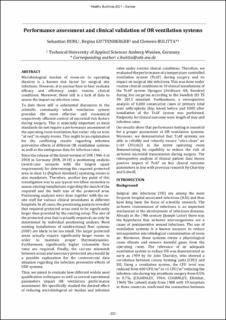| dc.description.abstract | Microbiological burden of room-air in operating theatres is a known risk factor for surgical site infections. However, it is unclear how to best evaluate efficacy and efficiency under routine clinical conditions. Moreover, there still is a lack of data to assess the impact on infection rates. To date there still is substantial discussion in the scientific community which ventilation system provides the most effective and economical respectively efficient control of microbial risk factors during surgery. This is especially important as most standards do not require a performance assessment of the operating room ventilation, but rather rely on tests “at rest” in empty rooms. This might be an explanation for the conflicting results regarding infection preventive effects of different OR ventilation systems as well as the ambiguous data for infection rates. Since the release of the latest version of DIN 1946-4 in 2018 in Germany [DIN, 2018] a positioning analysis (worst-case scenario with the largest space requirement) for determining the required protected area in class 1a (highest standard) operating rooms is also mandatory. Therefore, another key point of this investigation was to use typical workflow scenarios to assess existing installations regarding the match of the required and the built size of the protected area. Positioning analyses were done together with the onsite staff for various clinical procedures in different hospitals. In all cases, the positioning analysis revealed that required protected areas need to be significantly larger than provided by the existing setup. The size of the protected area that is actually required can only be determined by individual positioning analysis. Most existing installations of unidirectional flow systems (UDF) are likely to be too small. The larger protected areas actually require significantly larger rooms in order to maintain proper thermodynamics. Furthermore, significantly higher volumetric flow rates are required. Finally, the current mismatch between actual and necessary protected area would be a possible explanation for the controversial data situation regarding the infection preventive effects of UDF systems. Thus, we aimed to evaluate how different widely used qualification techniques as well as several operational parameters impact OR ventilation performance assessment. We specifically studied the desired effect of reducing microbiological air burden and infection rates under routine clinical conditions. Therefore, we evaluated the performance of a temperature controlled ventilation system (TcAF) during surgery and its impact on surgical site infections. This was done under routine clinical conditions in 10 clinical installations of the TcAF system Opragon (Avidicare AB, Sweden) during live surgeries according to the Swedish SIS TS 39: 2015 standard. Furthermore, a retrospective analysis of 1,000 consecutive cases of primary total joint arthroplasty (hip, knee) before and 1000 after installation of the TcAF system was performed. Endpoints for clinical outcome were length of stay and infection rates. Our results show that performance testing is essential for a proper assessment of OR ventilation systems. Moreover, we demonstrated that TcAF systems are able to reliably and robustly ensure "ultra-clean" air (<10 CFU/m3) in the entire operating room demonstrating its capability to reduce the risk of airborne microbial transmission during surgery. The retrospective analysis of clinical patient data shows positive impact of TcAF on key clinical outcome parameters in line with previous research by Charnley and Lidwell. | |

